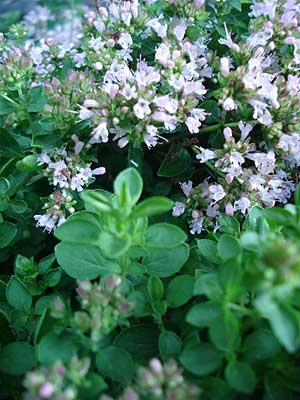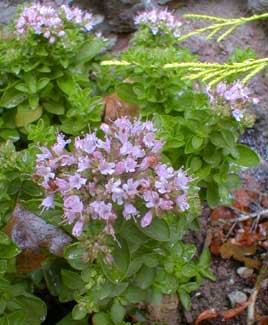
Compact Greek Oregano;
aka, 'Humile' Dwarf Marjoram
or Creeping Oregano
"A hundred things come in the door,
The scent of herbs, the thought of yore."
-Lizette Woodworth Reese
(1856-1935)
(1856-1935)
Origanum vulgar ssp hirtum 'Humile' is the correct preferred name for this little perennial, synonymous with O. vulgar 'Compacta Nana' & sometimes sold as though with a subspecies name, O. compacta nana or O. vulgar humile, sometimes with its name reversed as 'Nana Compacta,' & elsetimes simply as either 'Compacta' or 'Nana.' It is sometimes mistakenly labeled 'Compactum' which should be reserved for Moroccan Oregano, O. campactum.
 'Compacta Nana' means it has densely compacted leafiness, & is a dwarf variety; the correct name 'Humile' alludes to its extremely short stature. It is not rampant or loosely spreading like regular two-foot-tall O. vulgar hirtum, but instead forms tight almost formal looking mounds, so that it is an excellent ornamental herb.
'Compacta Nana' means it has densely compacted leafiness, & is a dwarf variety; the correct name 'Humile' alludes to its extremely short stature. It is not rampant or loosely spreading like regular two-foot-tall O. vulgar hirtum, but instead forms tight almost formal looking mounds, so that it is an excellent ornamental herb.Being a good deal smaller than most oreganos, 'Humile' can sometimes mound up to ten inches tall, though four to six inches is more likely, with a minimal twelve inch spread. If grown from seed, it will be only one-inch very dense flat groundcover its first year. If it afterward gets much taller than preferred, it is very amenable to shearing, & the sheared bits can go straight to the kitchen to use immediately, or to dry for winter use.
The small dark green leaves & bracts are very fragrant when disturbed or crushed. It's an excellent culinary oregano & makes an especially good flavoring for soups, fried potatoes, casseroles, or mixed with finely chopped green onions, basil, & mushrooms for an omelet.
Leaves can be steeped in olive oil for a flavored oil for salads or cooking. If in the past all one has experienced is the sort of stale dried oregano available in jars or tins from a supermarket, & which can taste a bit like pencil shavings, then you will be amazed by the aromatic strength & tastiness of this oregano whether used fresh or freshly dried.
Marjorams or oreganos are loved by bees, but usually overlooked by deer. Flowers ranging from white to pale lavender-pink occur in summer, in our garden especially in July & August. These can be taken with some leaves to use as nosegays or miniature flower arrangements called tussy-mussies.
Though both cold & heat hardy, it does not like wet ground, & may turn black in rainy autumns or winters, or die altogether. In well-drained soil such as on a garden ledge, it can behave as a semi-evergreen through much of winter (in our mild Zone 8 region at least).
It should have full sun either all morning or preferably all afternoon, but won't complain if it is in shade the other half of the day. If it likes its location it should be very low-maintenance, the occasional shearing for kitchen use being all the attention it requires to keep itself revitalized.
As a medicinal herb, O. vulgare is one of the species widely tested. The essential oils possess numerous phenolic chemical components that are antimicrobial, antiviral, anti-hyperglycaemic (for patients with diabetes), antifungal, immunostimulatory, anstispasmodic, & antioxidant in their effects.
A 2002 study by Goun et al conducted at the University of Central Florida's Department of Chemistry discovered an antithrombin effect of aristolochic acids from O. vulgare, which are potentially useful in treating leukemia.
A 2001 animal-modeled study by Manohar et al conducted by the Department of Physiology and Biophysics, Georgetown University Medical Center in Washington, D.C., found that orally given origanum oil's antifungal activity was helpful in treating Candida, & the study speculated that further study might well discover "broad spectrum effect against other pathogenic manifestations including malignancy."
A 2004 Swiss study by Mauch & Bilkei found that essential oils of oregano added to swine feeds lowered sow mortality & increased reproductive performance. Dried or powdered leaves would not have the same high degree of medicinal value as essential oils, but there could still be some benifit, for a 2001 Croatian study by Nahrung et al found that yields of volatile compounds though greatly reduced could still be obtained from dried O. vulgare.
The volatile oils are even more highly regarded as a meat preservative & has been used as a natural fungicide on crops. It furthermore has moderate insecticidal & mulluscidal (snail-killing) properties.
It's a harsh but true observation that the alternative medicines community promotes most extravagantly herbs such as echinacea & ginkgo biloba which in doubleblind studies prove useless for just about everything they are recommended for, but actually benificial herbs are not as popular. This is partly because worthless herbs have no higher market layer, so can be obtained cheaply & sold dearly. It is also because the most effective herbs are potentially the most dangerous, & the alternative medicine community has trained itself to vend herbs with the least toxic side-effects, & thereby also the least possibility of effectiveness.
In the case of oregano, which is generally safe & has measurable & proven health values, it is so easily available as a kitchen herb that vendors of herbal remedies cannot obtain it as cheaply, & could not get away with overpricing it for public consumption. So oregano remains in the food aisles while herbs with little to no medicinal value will be priced very high in the unutterably faux natural healing aisle.
Though "generally" safe, there is some risk, as there is nothing potent enough to have benefit that is totally lacking in side-effects. Oregano has a potential for serious toxic response in large doses of pure extracts. Essential oils of oregano & other highly redolent herbs, including pennyroyal, have been used throughout South America to induce abortions by infusion, ingestion, or injection, immediately indicating they are contraindicated for women who wish to remain pregnant.
Use of the whole leaves in the kitchen do not pose the same risk as the extracted oils. But for the extracts, a 2003 Uruguay study by Ciganda & Laborde looked at cases of herbally induced abortions & found they sometimes involved "multiple organ system failure," hence risked lasting physical damage or death.
Allergic reactions are also common with volatile herbal oils. So it is perhaps a good thing the alternative medicine pushers in health food stores prefer peddling worthless herbs like echinacea & gingko that present only the danger that users are duped into not seeking actual medical assistance for treatable health problems.